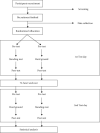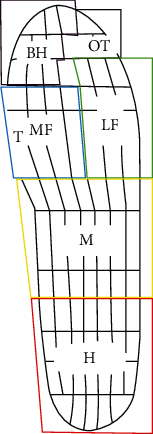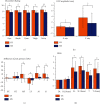The Effect of Standing Mats on Biomechanical Characteristics of Lower Limbs and Perceived Exertion for Healthy Individuals during Prolonged Standing
- PMID: 35942253
- PMCID: PMC9356849
- DOI: 10.1155/2022/8132402
The Effect of Standing Mats on Biomechanical Characteristics of Lower Limbs and Perceived Exertion for Healthy Individuals during Prolonged Standing
Abstract
Objective: To identify the effect of standing mats on biomechanical characteristics of lower limbs and perceived exertion for healthy adult individuals during a prolonged standing task.
Methods: 32 healthy college students were recruited in the randomized and cross-over designed trial according to the effect size and statistical power. After collecting the anthropometric data, each participant was asked to finish 2 sessions of 4-hour prolonged standing tasks on standing mats (MS) and hard ground (GS) in a random order and with a 72-hour interval rest. The plantar pressure distribution, foot morphology, and scores of the BESS (balance error scoring system) would be recorded pre- and posteach task. The Borg Rating of Perceived Exertion (RPE) would be collected during the whole task. Paired-samples t test was adopted to analyse the before and after difference within group and independent-samples t test was adopted to analyse the difference between groups separately.
Results: (1) A prolonged standing task on both MS and GS have a negative effect on RPE and balance performance. (2) The negative effect on RPE and balance performance induced by MS is significantly smaller than that induced by GS. (3) Compared to GS, prolonged standing on MS has a lower peak plantar pressure and an implicit decrease in navicular drop and AHI (arch index).
Conclusion: Standing mat tends to alleviate the fatigue induced by prolonged standing in lower limbs, optimize the distribution of plantar pressure, and maintain the stability.
Copyright © 2022 Yan Zhang et al.
Conflict of interest statement
The authors declare that there is no conflicts of interest regarding the publication of this paper.
Figures






Similar articles
-
Gait Characteristics and Fatigue Profiles When Standing on Surfaces with Different Hardness: Gait Analysis and Machine Learning Algorithms.Biology (Basel). 2021 Oct 22;10(11):1083. doi: 10.3390/biology10111083. Biology (Basel). 2021. PMID: 34827076 Free PMC article.
-
Erratum.Mult Scler. 2016 Oct;22(12):NP9-NP11. doi: 10.1177/1352458515585718. Epub 2015 Jun 3. Mult Scler. 2016. PMID: 26041800
-
Effects of anti-fatigue mats on perceived discomfort and weight-shifting during prolonged standing.Hum Factors. 2013 Aug;55(4):764-75. doi: 10.1177/0018720812466672. Hum Factors. 2013. PMID: 23964416
-
Relationships between clinical measures of static foot posture and plantar pressure during static standing and walking.Clin Biomech (Bristol). 2011 Oct;26(8):873-9. doi: 10.1016/j.clinbiomech.2011.04.008. Epub 2011 May 31. Clin Biomech (Bristol). 2011. PMID: 21632159
-
Effects of Resistance Training to Muscle Failure on Acute Fatigue: A Systematic Review and Meta-Analysis.Sports Med. 2022 May;52(5):1103-1125. doi: 10.1007/s40279-021-01602-x. Epub 2021 Dec 9. Sports Med. 2022. PMID: 34881412
Cited by
-
Evaluating walkability across age groups and flooring materials using IMU sensors.Front Public Health. 2024 Dec 5;12:1509602. doi: 10.3389/fpubh.2024.1509602. eCollection 2024. Front Public Health. 2024. PMID: 39703485 Free PMC article.
-
Relationship Between Orthostatic Cardiovascular Responses and Anthropometric Indices in Apparently Healthy Young Female Adults.Cureus. 2025 Apr 1;17(4):e81569. doi: 10.7759/cureus.81569. eCollection 2025 Apr. Cureus. 2025. PMID: 40313456 Free PMC article.
-
Changes in Baropodometric Evaluation and Discomfort during the Workday in Assembly-Line Workers.Healthcare (Basel). 2024 Mar 31;12(7):761. doi: 10.3390/healthcare12070761. Healthcare (Basel). 2024. PMID: 38610183 Free PMC article.
-
Ergonomic Challenges and Considerations in Endoscopic Treatment of Benign Prostatic Hyperplasia.Curr Urol Rep. 2025 Apr 15;26(1):37. doi: 10.1007/s11934-025-01266-4. Curr Urol Rep. 2025. PMID: 40232581 Review.
References
-
- Hanada M. Behavioral studies in the newborn infant--from the stand point of neuro-psychiatric development. Seishin Shinkeigaku Zasshi . 1970;72(1):61–80. - PubMed
-
- Liaw M. Y., Wong M. K. The effects of leg elevation to reduce leg edema resulting from prolonged standing. Taiwan Yi Xue Hui Za Zhi. Journal of the Formosan Medical Association . 1989;88(6):630–634. - PubMed
LinkOut - more resources
Full Text Sources

